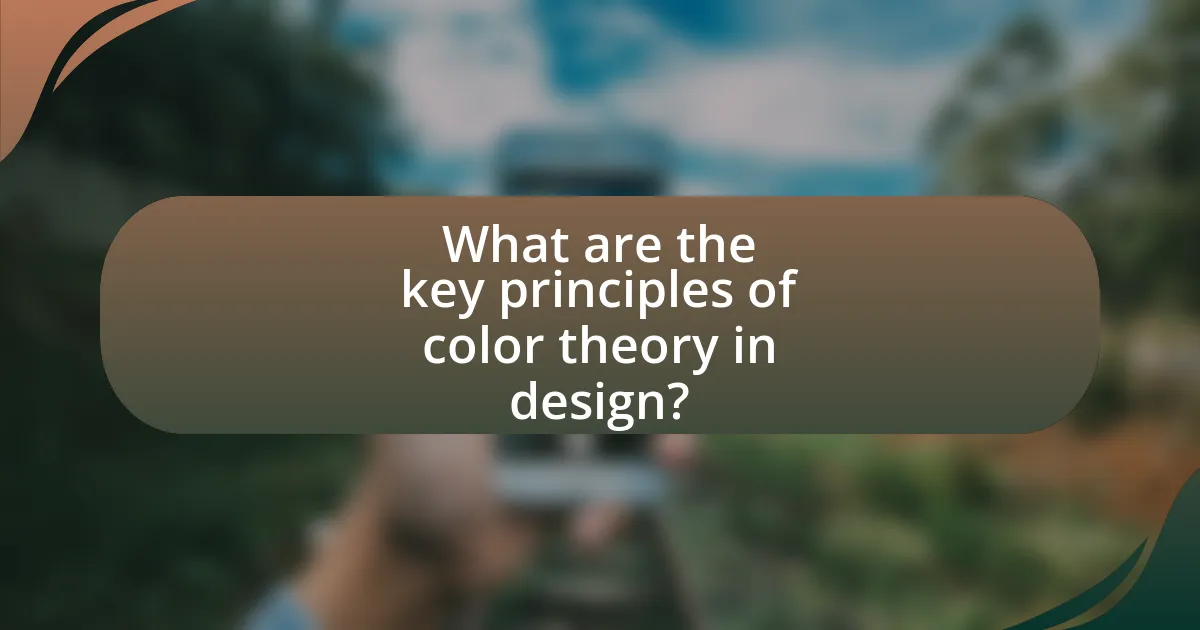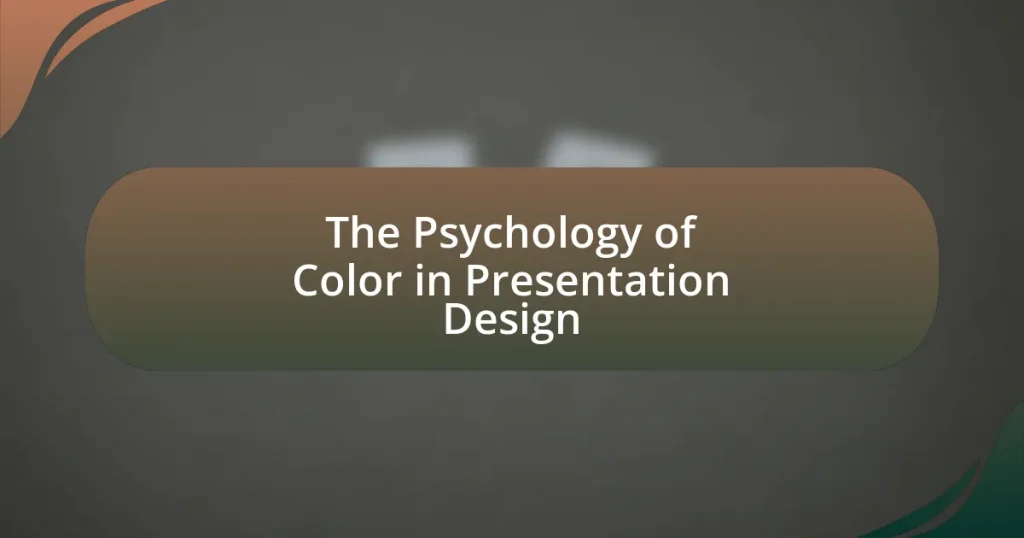The psychology of color in presentation design examines how different colors affect audience perception and emotional responses. It highlights the importance of color choice in enhancing comprehension, retention, and engagement, with research indicating that effective color use can boost audience engagement by up to 80%. The article explores the psychological effects of various colors, cultural interpretations, and the principles of color theory, emphasizing the significance of contrast, harmony, and accessibility in design. Additionally, it provides practical strategies for selecting color palettes and avoiding common mistakes to ensure effective communication in presentations.

What is the Psychology of Color in Presentation Design?
The psychology of color in presentation design refers to how different colors influence audience perception and emotional response. Colors can evoke specific feelings and associations; for example, blue often conveys trust and professionalism, while red can evoke excitement or urgency. Research indicates that color can increase comprehension and retention of information, with studies showing that presentations using color effectively can enhance audience engagement by up to 80%. Understanding these psychological effects allows designers to strategically choose colors that align with their message and audience, ultimately improving the effectiveness of their presentations.
How does color influence audience perception in presentations?
Color significantly influences audience perception in presentations by evoking emotions and shaping attitudes. For instance, research indicates that warm colors like red and orange can create feelings of excitement and urgency, while cool colors such as blue and green tend to promote calmness and trust. A study published in the journal “Color Research and Application” by researchers Andrew Elliot and Markus Maier found that color can affect cognitive performance and decision-making, demonstrating that the choice of color in presentation design can impact how information is received and processed. Thus, the strategic use of color not only enhances visual appeal but also plays a crucial role in audience engagement and comprehension.
What psychological effects do different colors have on emotions?
Different colors evoke specific psychological effects on emotions. For instance, red often stimulates feelings of excitement and urgency, while blue tends to promote calmness and trust. Research indicates that warm colors like yellow and orange can enhance feelings of happiness and energy, whereas cool colors such as green and purple are associated with tranquility and creativity. A study published in the journal “Color Research and Application” by Andrew Elliot and Markus Maier found that color can significantly influence mood and behavior, demonstrating that colors can affect emotional responses in various contexts, including presentation design.
How do cultural differences affect color interpretation?
Cultural differences significantly affect color interpretation, as colors can evoke varying emotions and meanings across different societies. For instance, in Western cultures, white is often associated with purity and weddings, while in many Eastern cultures, it symbolizes mourning and funerals. Research by the International Journal of Psychology highlights that color perception is influenced by cultural context, with studies showing that individuals from different backgrounds interpret colors based on their cultural experiences and societal norms. This demonstrates that understanding these cultural nuances is essential for effective communication in presentation design, as the same color can convey entirely different messages depending on the audience’s cultural background.
Why is color choice important in presentation design?
Color choice is important in presentation design because it influences audience perception and engagement. Specific colors can evoke emotions, enhance comprehension, and reinforce brand identity. For instance, research indicates that colors like blue can promote trust and calmness, while red can stimulate excitement and urgency. According to a study published in the journal “Color Research and Application,” 90% of snap judgments made about products can be based on color alone, highlighting its significant impact on audience reactions. Thus, effective color selection is crucial for conveying messages clearly and effectively in presentations.
What role does color play in enhancing message retention?
Color significantly enhances message retention by influencing emotional responses and cognitive processing. Research indicates that colors can evoke specific feelings and associations, which aids in memory recall. For instance, a study published in the journal “Applied Cognitive Psychology” found that information presented with color is 55% more likely to be remembered than information presented in black and white. This effect occurs because color captures attention and helps to organize information, making it easier for the brain to encode and retrieve the message later.
How can color impact the credibility of a presentation?
Color significantly impacts the credibility of a presentation by influencing audience perception and emotional response. Research indicates that colors can evoke specific feelings and associations; for example, blue is often linked to trust and professionalism, while red can convey urgency or excitement. A study published in the journal “Color Research and Application” by Satyendra Singh found that up to 90% of snap judgments made about products can be based on color alone, highlighting its importance in establishing credibility. Therefore, the strategic use of color in presentations can enhance the perceived reliability of the content and the presenter.

What are the key principles of color theory in design?
The key principles of color theory in design include the color wheel, color harmony, and the psychological effects of colors. The color wheel, developed by Isaac Newton, organizes colors into primary, secondary, and tertiary categories, providing a visual representation of relationships between colors. Color harmony refers to the aesthetically pleasing combinations of colors, such as complementary, analogous, and triadic schemes, which create balance and visual interest in design. The psychological effects of colors influence emotions and perceptions; for example, blue often conveys calmness, while red can evoke excitement or urgency. These principles guide designers in creating effective visual communication that resonates with audiences.
How do primary, secondary, and tertiary colors interact?
Primary, secondary, and tertiary colors interact through a systematic relationship defined by color theory. Primary colors—red, blue, and yellow—serve as the foundation for creating secondary colors, which are formed by mixing two primary colors: green (blue and yellow), orange (red and yellow), and purple (red and blue). Tertiary colors arise from mixing a primary color with a secondary color, resulting in hues like red-orange and blue-green.
This interaction is crucial in design, as it influences visual harmony and emotional response. For instance, complementary colors (opposite each other on the color wheel) create contrast and can evoke strong emotional reactions, while analogous colors (next to each other) promote a sense of unity and calm. Understanding these interactions allows designers to effectively use color to convey messages and enhance audience engagement in presentations.
What are complementary colors and how do they work together?
Complementary colors are pairs of colors that, when combined, cancel each other out, producing a grayscale color like white or black. They are located opposite each other on the color wheel, such as blue and orange or red and green. When used together in design, complementary colors create high contrast and vibrant visuals, enhancing the overall aesthetic appeal and drawing attention to key elements. This principle is supported by color theory, which indicates that complementary colors can stimulate visual interest and improve readability in presentations, making them effective for engaging audiences.
How can analogous colors create harmony in presentations?
Analogous colors create harmony in presentations by utilizing colors that are adjacent to each other on the color wheel, which naturally complement one another. This color scheme fosters a cohesive visual experience, making it easier for the audience to process information and maintain focus. Research in color theory indicates that analogous colors evoke a sense of unity and tranquility, enhancing the overall aesthetic appeal of the presentation. For instance, a study published in the Journal of Environmental Psychology found that harmonious color combinations can significantly improve viewer engagement and retention of information.
What is the significance of color contrast in presentations?
Color contrast in presentations is significant because it enhances readability and visual appeal, making information easier to process for the audience. High contrast between text and background colors improves legibility, which is crucial for effective communication. Research indicates that presentations with optimal color contrast can increase retention of information by up to 38%, as noted in studies by the University of Minnesota. This demonstrates that appropriate color contrast not only captures attention but also aids in the audience’s understanding and memory of the presented material.
How does contrast affect readability and viewer engagement?
Contrast significantly enhances readability and viewer engagement by making text and visuals more distinguishable. High contrast between background and foreground elements, such as dark text on a light background or vice versa, improves legibility, allowing viewers to process information quickly. Research indicates that optimal contrast levels can increase comprehension rates by up to 40%, as demonstrated in studies on visual perception and cognitive load. This heightened readability directly correlates with increased viewer engagement, as audiences are more likely to stay focused on content that is easy to read and visually appealing.
What are the best practices for using contrast effectively?
The best practices for using contrast effectively in presentation design include ensuring sufficient differentiation between text and background colors, utilizing complementary color schemes, and maintaining a balance between visual elements. Sufficient differentiation can be achieved by adhering to the 4.5:1 contrast ratio recommended by the Web Content Accessibility Guidelines (WCAG) for normal text, which enhances readability. Complementary color schemes, such as pairing blue with orange, create visual interest and draw attention to key information. Additionally, balancing visual elements prevents overwhelming the audience, allowing for a clear focus on the message being conveyed. These practices enhance engagement and comprehension in presentations.

How can color be effectively applied in presentation design?
Color can be effectively applied in presentation design by utilizing color theory principles to enhance visual communication and audience engagement. For instance, contrasting colors can improve readability and draw attention to key points, while harmonious color schemes can create a cohesive and professional look. Research indicates that colors evoke specific emotions; for example, blue often conveys trust and calmness, while red can evoke excitement or urgency. By strategically selecting colors that align with the message and desired emotional response, designers can significantly impact audience perception and retention of information.
What strategies can be used to select a color palette?
To select a color palette, one effective strategy is to understand color theory, which includes concepts like complementary, analogous, and triadic color schemes. Utilizing these principles helps create visually appealing and harmonious designs. For instance, complementary colors, which are opposite each other on the color wheel, can create high contrast and draw attention, while analogous colors, which are next to each other, provide a more serene and cohesive look. Research indicates that color choices can significantly impact audience perception and emotional response, as demonstrated in studies by the Institute for Color Research, which found that color increases brand recognition by up to 80%. Therefore, applying color theory strategically can enhance the effectiveness of presentations by aligning visual elements with psychological impacts.
How can branding influence color choices in presentations?
Branding significantly influences color choices in presentations by establishing a visual identity that resonates with the target audience. Companies often select specific colors that align with their brand values and evoke desired emotional responses; for instance, blue is commonly associated with trust and professionalism, while red can convey excitement and urgency. Research indicates that color can increase brand recognition by up to 80%, highlighting its importance in maintaining consistency across various platforms, including presentations. This consistency helps reinforce brand messaging and enhances audience engagement, making color selection a critical aspect of effective presentation design.
What tools are available for creating color schemes?
Tools available for creating color schemes include Adobe Color, Coolors, and Paletton. Adobe Color allows users to generate color palettes based on color theory principles, offering options like analogous, monochromatic, and complementary schemes. Coolors is a user-friendly tool that enables rapid color palette generation and exploration, allowing users to lock colors and adjust others easily. Paletton provides an interactive color wheel for creating harmonious color combinations, catering to various design needs. These tools are widely used in design and presentation contexts to ensure effective color usage that aligns with psychological principles.
What common mistakes should be avoided when using color?
Common mistakes to avoid when using color include poor contrast, overuse of colors, and neglecting color blindness considerations. Poor contrast can make text difficult to read, diminishing the effectiveness of the presentation. For instance, using light text on a light background can lead to readability issues. Overusing colors can create visual clutter, distracting the audience and undermining the message. Research indicates that a limited color palette enhances comprehension and retention. Additionally, failing to consider color blindness can alienate a portion of the audience; approximately 8% of men and 0.5% of women have some form of color vision deficiency. Therefore, using color combinations that are distinguishable for all viewers is crucial for effective communication.
How can overuse of color detract from a presentation’s message?
Overuse of color can detract from a presentation’s message by overwhelming the audience and causing confusion. When too many colors are used, it can lead to visual clutter, making it difficult for viewers to focus on key points. Research indicates that presentations with a limited color palette are more effective in conveying information, as they enhance readability and comprehension. For instance, a study published in the Journal of Educational Psychology found that presentations using three to five colors significantly improved audience retention compared to those with more than ten colors. This demonstrates that a balanced use of color is essential for clear communication in presentations.
What are the pitfalls of using too many colors in a design?
Using too many colors in a design can lead to visual confusion and decreased effectiveness of the message. When a design incorporates excessive colors, it can overwhelm the viewer, making it difficult to focus on key elements and diminishing the overall aesthetic appeal. Research indicates that designs with a limited color palette are more likely to be perceived as harmonious and professional, while those with too many colors can appear chaotic and unorganized. For example, a study published in the Journal of Experimental Psychology found that excessive color variety can impair cognitive processing, leading to reduced comprehension and retention of information.
What are some practical tips for using color in presentations?
To effectively use color in presentations, select a limited color palette that enhances readability and maintains audience engagement. Research indicates that using three to five colors can create a cohesive look while avoiding visual clutter. Additionally, consider the psychological impact of colors; for example, blue conveys trust, while red can evoke urgency. Ensure high contrast between text and background colors to improve legibility, as studies show that contrast increases comprehension. Finally, use color consistently throughout the presentation to reinforce branding and thematic elements, which helps in retaining audience attention and improving information retention.
How can presenters ensure color accessibility for all audiences?
Presenters can ensure color accessibility for all audiences by using high-contrast color combinations and avoiding color pairs that are difficult to distinguish for individuals with color vision deficiencies. Research indicates that approximately 8% of men and 0.5% of women have some form of color blindness, making it essential to select colors that are easily distinguishable, such as blue and yellow, rather than red and green. Additionally, incorporating patterns or textures alongside color can enhance differentiation for all viewers. Tools like the WebAIM Color Contrast Checker can help presenters evaluate the accessibility of their color choices, ensuring that content is legible and inclusive for everyone.
What are the best practices for testing color choices before a presentation?
The best practices for testing color choices before a presentation include using color contrast checkers, gathering feedback from diverse audiences, and conducting A/B testing with different color schemes. Color contrast checkers, such as the WebAIM Contrast Checker, ensure that text is legible against background colors, which is crucial for accessibility. Gathering feedback from a diverse audience helps identify how different demographics perceive color, as cultural differences can influence color interpretation. A/B testing allows presenters to compare audience engagement and retention rates with varying color palettes, providing data-driven insights into which colors enhance the presentation’s effectiveness. These methods are supported by research indicating that color significantly impacts audience perception and emotional response, making thorough testing essential for successful presentations.
